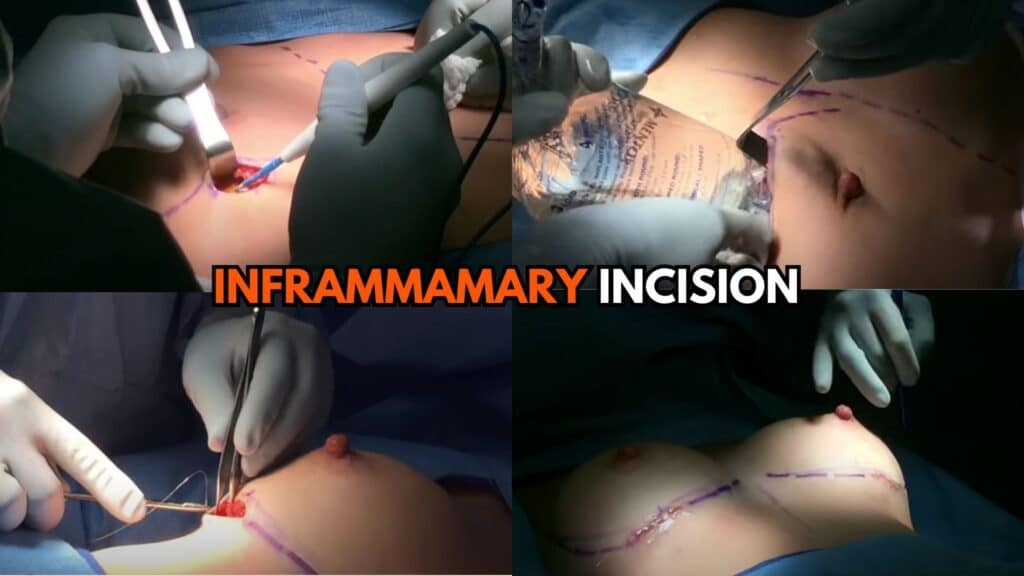
- March 20, 2023
- 2:44 pm
4 Incision Placement Options for Breast Augmentation: A Life-Changing Guide! Which is the best?
Table of Contents
Introduction:
Breast Augmentation Incision Placement Choices.
Breast augmentation is a popular cosmetic surgery procedure that can enhance the size and shape of the breasts. One of the most essential decisions patients must make when undergoing breast augmentation surgery is the choice of incision placement.
There are four main Incision Placement Options: periareolar, inframammary, transumbilical, and transaxillary.
In this article, we will provide a comprehensive guide to the pros and cons of each incision placement option to help patients decide which approach is best for them.

Periareolar Incision Placement
The periareolar incision placement option involves making a small incision around the areola, which is the pigmented skin surrounding the nipple. The surgeon then creates a pocket for the breast implant behind the breast tissue or muscle.
Benefits of Periareolar Incision Placement
- Scarring: The incision is hidden along the border of the areola, which can make the scar less visible than other incision placement options.
- Direct Access: The surgeon has direct access to the breast tissue and muscle, which can allow for better placement and positioning of the implant.
- Combined Procedures: The incision location is suitable for combined procedures, such as a breast lift, that require access to the breast tissue.
Drawbacks of Periareolar Incision Placement
- Risk of Complications: The periareolar incision placement option can increase the risk of complications, such as loss of nipple sensation, infection, and implant malposition.
- Limited Implant Size: The size of the implant that can be inserted through a periareolar incision is limited due to the small size of the incision.

Inframammary Incision Placement
The inframammary incision placement option involves making a small incision along the fold where the breast meets the chest wall. The surgeon then creates a pocket for the breast implant behind the breast tissue or muscle.
Benefits of Inframammary Incision Placement
- Implant Size: The size of the implant that can be inserted through an inframammary incision is not limited, which can be beneficial for patients seeking a larger breast size.
- Reduced Risk of Complications: The inframammary incision placement option has a lower risk of complications, such as loss of nipple sensation, infection, and implant malposition, than the periareolar incision placement option.
Drawbacks of Inframammary Incision Placement
- Scarring: The incision is visible on the lower part of the breast, which can make the scar more visible than other incision placement options.
- Limited Combined Procedures: The incision location is not suitable for combined procedures, such as a breast lift, that require access to the breast tissue.

Transumbilical Incision Placement
The transumbilical incision placement option involves making a small incision in the belly button area, and then creating a tunnel to the breast area where the implant is inserted.
Benefits of Transumbilical Incision Placement
- Scarring: The incision is hidden in the belly button area, which can make the scar less visible than other incision placement options.
- Reduced Risk of Complications: The transumbilical incision placement option has a lower risk of complications, such as loss of nipple sensation, infection, and implant malposition, than the periareolar and inframammary incision placement options.
- Minimal Pain: Patients report minimal pain and discomfort following the surgery.
Drawbacks of Transumbilical Incision Placement
- Limited Implant Placement: The surgeon has limited control over the placement of the implant and cannot access the breast tissue or muscle, which can result in less precise placement.
- Limited Implant Size: The size of the implant that can be inserted through a transumbilical incision is limited due to the size of the incision.

Transaxillary Incision Placement
The transaxillary incision placement option involves making an incision in the armpit, through which a tunnel is created to insert the breast implant. Here are some of the benefits and drawbacks of this incision placement option:
Benefits of Transaxillary Incision Placement
- Hidden Scarring: The transaxillary incision placement option results in a hidden scar in the armpit, which can be concealed when wearing sleeveless clothing.
- No Scarring on the Breast: This incision placement option does not result in any scarring on the breast itself.
Drawbacks of Transaxillary Incision Placement
- Limited Control over Implant Placement: The surgeon has limited control over the placement of the implant, which can result in less precise placement and symmetry.
- Limited Implant Size: The size of the implant that can be inserted through a transaxillary incision is limited due to the size of the incision.
Pros and Cons Comparison Chart
To summarize the information presented above, here is a comparison chart of the pros and cons of each incision placement option:
| Incision Placement Option | Pros | Cons |
|---|---|---|
| Periareolar | Less visible scarring | Higher risk of complications |
| Direct access to breast tissue | ||
| Minimal pain | ||
| Inframammary | Accommodates larger implants | Visible scarring |
| Lower risk of complications | ||
| Minimal pain | ||
| Transumbilical | Least visible scarring | Limited implant placement |
| Minimal pain | Limited implant size | |
| Surgeon has limited control over implant placement and symmetry | ||
| Transaxillary | Hidden scarring | Limited implant placement |
| No scarring on the breast | Limited implant size | |
| Surgeon has limited control over implant placement and symmetry. |
Read more about “Transaxillary Pros & Cons.“
Frequently Asked Questions
Q: Can I choose which incision placement option to use for my breast augmentation surgery?
A: Yes, you can work with your surgeon to choose the incision placement option that is best for you.
Q: Will I have scars after breast augmentation surgery?
A: Yes, all incision placement options will result in some scarring, but the extent and visibility of the scar will vary depending on the placement option.
Q: Can all four incision placement options be used for any type of breast implant?
A: Yes, all four incision placement options can be used for saline or silicone breast implants.
Q: Will the incision placement option affect my recovery time?
A: Recovery time is generally the same for all four incision placement options.
Q: Can I breastfeed after having breast augmentation surgery?
A: Yes, breast augmentation surgery should not affect a woman’s ability to breastfeed.
Conclusion
Choosing the right incision placement option for your breast augmentation surgery is an important decision that should be made in consultation with your surgeon. Each option has its own set of benefits and drawbacks, and the best option for you will depend on your individual needs and preferences. With this comprehensive guide, we hope that you have a better understanding of the pros and cons of each incision placement option and can make an informed decision about which approach is best for you.









